Thoroughly analyzing AP Inter 2nd Year Physics Model Papers Set 1 helps students identify their strengths and weaknesses.
AP Inter 2nd Year Physics Model Paper Set 1 with Solutions
Time: 3 Hours
Maximum Marks: 60
Section – A
Answer all questions. Each carries two marks. (10 × 2 = 20 Marks)
Question 1.
What is Doppler effect ? Give an example.
Answer:
Doppler effect: The apparent change in the frequency heard by the observer due to relative motion between source of sound and observer is called “Doppler effect”.
E.g.: When the whistling railway engine approaches the stationary observer on the platform, the frequency of sound appears to increase above the actual frequency. When it moves away from the observer, the apparent frequency decreases.
Question 2.
What is myopia ? How can it be corrected ?
Answer:
Myopia (or) Near sightedness :
The light from a distant object arriving at the eye-lens may get converged at a point infront of the retina. This type of defect is called myopia.
To correct this, we interpose a concave lens between the eye and the object.

![]()
Question 3.
How many electrons constitute 1C of charge?
Answer:
n = \(\frac{\mathrm{q}}{\mathrm{e}}=\frac{1}{1.6 \times 10^{-19}}\) nr = 6.25 x 1018 electrons.
Question 4.
Three capacitors of capcitances 1μF, 2μF and 3μF are connected in parallel
(a) what is the ratio of charges ?
(b) What is the ratio of potential differences ? 1
Answer:
When capacitors are connnecfed in parallel
(a) q1 : q2 : q3 = C1 V : C2 V : C V= 1μF : 2μF : 3μF
∴ q1 : q2 : q3 = 1 : 2 : 3
(b) V1 : V2 : V3 = V : V : V = 1 : 1 : 1
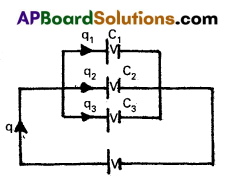
Question 5.
Why is manganin used for making standard resistors ?
Answer:
Due to high resistivity and low temperature coefficient of resistance, manganin wire (Cu-84% + Mn – 12% + Ni – 4%) is used in the preparation of standard resistances.
Question 6.
How do you convert a moving coil galvanometer into an ammeter ?
Answer:
A small resistance is connected in parallel to the moving coil galva-nometer, then it converts to Ammeter.

Question 7.
Magnetic lines form continuous closed loops. Why ?
Answer:
Magnetic lines of force always start from north pole and forming curved path, enter south pole and travel to north pole inside the magnet. Thus lines of force are forming closed loops.
Question 8.
Write down Einsteins photoelectric equation ?
Answer:
Einstein’s photoelectric equation is given by
Kmax = \(\frac{1}{2}\) mv2rmax = hυ – Φ0.
![]()
Question 9.
Draw the circuit symbols for p-n-p and n-p-n transistors ?
Answer:
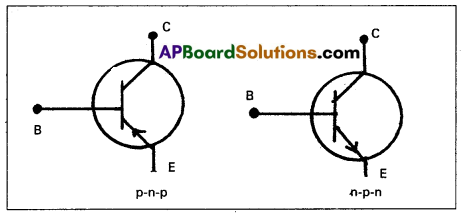
Question 10.
Define modulation. Why is it necessary ?
Answer:
Modulation: The process of combining low frequency audio signal with high frequency carrier wave is called modulation.
Section – B
Answer any six questions. Each carries four marks. (6 × 4 = 24 Marks)
Question 11.
Explain the modes of vibration of an open pipe.
Answer:
Modes of vibration of an air column in an open pipe :
1) For a open pipe both the ends are open. So anjtinodes will be formed at both the ends. But two antinodes cannot exist without a node between them.
2) The possible harmonics in vibrating air column of a open pipe is given by v = \(\frac{\mathrm{nυ}}{2 l}/latex]. Where n = 1, 2, 3
3) In first normal Mode of vibrating air column in a open pipe, v1 = [latex]\frac{\mathrm{υ}}{2 l}\) = υ
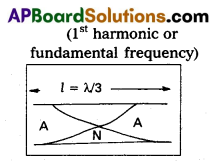
4) In second normal Mode of vibrating air column in a open v2 = \(\frac{\mathrm{2 υ}}{2 l}\) = 2v
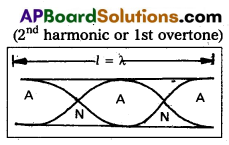
5) In third, normal Mode of vibrating air column in a open pipe, v3 = \(\frac{\mathrm{3 υ}}{2 l}\) = 3υ

6) In open pipe the ratio of frequencies of harrrjonics is
v1 : v2 ; v3 = v : 2v : 3v = 1 : 2 : 3
Question 12.
Explain Doppler effect in light. Distinguish between red shift and blue shift.
Answer:
Doppler effect in light: The change in the apparent frequency of light, due to relative motion between source of light and observer. This phenomenon is called Doppler effect.
The apparent frequency of light increases when the distance between observer and source of light is decreasing and the apparent frequency of light decreases, if the .distance between source of light and observer increasing.
Doppler shift can be expressed as \(\frac{\Delta v}{v}=\frac{-v_{\text {radial }}}{c}\)
Applications of Doppler effect in light:
- It is used in measuring the speed of a star and speed of galaxies.
- Measuring the speed of rotation of the sun.
Red shift: The apparent increase in wave length in the middle of the visible region of the spectrum moves towards the red end of the spectrum is called red shift.
Blue shift: When waves are received from a source moving towards the observer, there is an apparent decrease in wave length, this is called blue shift.
Question 13.
Derive an expression for the energy stored in a capacitor ?
Answer:
Expression for the energy stored in a capacitor : Consider an uncharged capacitor of capacitance ‘c’ and its initial will be zero. Now it is connected across a battery for charging then the final potential difference across the capacitor be V and final charge on the capacitor be ‘Q’
∴ Average potential difference VA = \(\frac{O+V}{2}=\frac{V}{2}\)
Hence workdone to move the charge Q = W = VA × Q = \(\frac{V Q}{2}\)
This is stored as electrostatic potential energy ‘U’
∴ U = \(\frac{Q V}{2}\)
We know Q = CV then ‘U’ can be written as given below.
U = \(\frac{Q V}{2}\) = \(\frac{1}{2}\) CV2 = \(\frac{Q^2}{2 C}\)
∴ Energy stored in a capacitor
U = \(\frac{Q V}{2}\) = \(\frac{1}{2}\) CV2 = \(\frac{1}{2}\) \(\frac{Q^2}{ C}\)
Effect of Dielectric on energy stored :
Case (a) : When the charging battery is disconnected from the circuit:
If the capacitor is charged by a battery and the disconnected from the circuit. Now the space between the plates is filled with a dielectric of dielectric constant ‘K’ then potential decreases by \(\frac{1}{\mathrm{~K}}\) times and charge remains constant.
Capacity increases by ‘K’ times
New capacity C’= \(\frac{Q}{V}\) =\(\frac{\mathrm{Q}}{\frac{\mathrm{V}}{\mathrm{K}}}\) = K\(\frac{Q}{V}\) = KC [∵ C = \(\frac{Q}{V}\)]
∴ C’ = KC
Energy stored U’ = \(\frac{1}{2}\) QV’ = \(\frac{1}{2}\) Q \(\frac{V}{K}\) = \(\frac{U}{K}\) [∵ V’ = \(\frac{V}{K}\)]
U’ = \(\frac{U}{K}\)
∴ Energy stored decreases by \(\frac{1}{\mathrm{~K}}\) times.
Case (b): When the charging battery is connected in the circuit: Let the charging battery is continue the supply of charge. When the dielectric is introduced then potential decreases by \(\frac{1}{\mathrm{~K}}\) times and charge on the plates increases until the potential difference attains the original value = V’
New charge on the plates Q’ = KQ
Hence new capacity C’ = \(\frac{Q^{\prime}}{V}=\frac{K Q}{V}\) = K.C.
Energy stored in the capacitor U’ = \(\frac{1}{2}\)Q’V = \(\frac{1}{2}\)(KQ) V – KU
U’ = KU
∴ Energy stored in the capacitor increases by ‘K’ times.
Question 14.
Derive the balancing condition of a Wheatstone bridge ?
Answer:
1) Kirchhoff’s first law (Junction rule or KCL) : The algebraic sum of the currents at any junction is zero. ∴ ΣI = 0
(or)
The sum of the currents flowing towards a junction is equal to the sum of currents away from the junction.
2) Kirchhoffs second law (Loop rule or KVL) : the algebraic sum of potential around any closed loop is zero.
∴ Σ(IR) + ΣE = 0
Wheatstone bridge: Wheatstone’s bridge circuit consists of four resistances R1, R2, R3 and R4 are connected to form a closed path. A cell of emf e is connected between the point A and C and a galvanometer is connected between the points B and D as shown in fig. The current through the various branches are indicated in the figure. The current through the galvanometer is Ig and the resistance of the galvanometer is G.
Applying Kirchhoffs first law
at the junction D, I1 – I3 – Ig = 0 ………… (1)
at the junction B, I2 + Ig – I4 = 0 ………….. (2)
⇒ Applying Kirchhoffs second law to the closed path ADBA
-I1R1-IgG + I2R2 = 0
or
⇒ I1R1 – IgG + I2R2
⇒ to the closed path DCBD
-I3R3 + I4R4 + IgG = 0
⇒ I3R3 – IgG = I4R4
⇒ When the galvanometer shows zero deflection the points D and B are at the same potential so Ig = 0.
Substituting this value in (1), (2), (3) and (4).
I1 = I3 – (5)
I2 = I4 – (6)
I1R1 = I2R2 – (7)
I3R3 = I4R4 – (8)
⇒ Dividing (7) by (8)
\(\frac{I_1 R_1}{I_3 R_3}=\frac{I_2 R_2}{I_4 R_4} \Rightarrow \frac{R_1}{R_3}=\frac{R_2}{R_1}\)
[∵ I1 = I3 & I2 = I4]
∴ Wheatstone’s Bridge principle : R4 = R3 × \(\frac{\mathrm{R}_2}{\mathrm{R}_1}\)
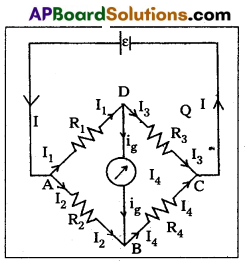
![]()
Question 15.
Compare the properties of para, Dia and ferromagnetic substances.
Answer:
| Diamagnetic substances | Paramagnetic substances | Ferromagnetic substances |
| a) When these materials placed in a magnetic field, they are magne tised feebly in the opposite direction to the applied external field. | a) When these materials placed in a magnetic field, they are magnetised feebly in the direction of the applied magnetic field. | a) When these materials placed in a magnetic field, they are magnetised strongly in the direction of the applied external field. |
| b) When a rod of diamagnetic material issus-pended freely in a uniform magnetic field, it comes to rest in the perpendicular direction to the magnetic field. | b) When a rod of paramagnetic material is suspended freely in a uniform magnetic field, it comes to rest in the direction of the applied magnetic field. | b) When a rod of ferromagnetic material is suspended freely in a uniform magnetic field, it comes to rest in the direction of the applied magnetic field. |
| c) When they kept in a non-uniform magnetic field, they moves from the region of greater field strength to the region of less field strength. | c) When they kept in anon-uniform magnetic field, they form magnetic field they moves from the region of greater field strength to the region of greater field strength. | c) When they kept in anon-uniform magnetic field they moves from the regions of lesser (magnetic field) strength to the regions of stronger (magnetic field) strength. |
| d) The relative permeability is less than 1. μr < 1 and positive. |
d) The relative permeability is greater than 1. μr > 1 and positive. | d) The relative permeability is much greater than 1. μr >> 1. |
| e) The susceptibility (χ) is low and negative. E.g. : Copper, Silver, water, gold,antimony, bismuth, mercury, quartz diamond etc. |
e) The susceptibility (χ) is small and positive. E.g. : Aluminium, Magnetism,Tungsten, Platinum, Manganese, liquid oxygen, ferric Chloride, cupric chloride etc. |
e) The susceptibility (χ) is highand positive. E.g. : Iron, Cobalt, Nickel, Gadolinium and their alloys. |
Question 16.
What is Greenhouse effect and its contribution towards the surface temperature of earth ?
Answer:
Green house effect : Temperature of the earth increases due to ‘ the radiation emitted by the earth is trapped by atmospheric gases like CO2, CH4, N2, Chlorofluoro carbons etc is called green house effect.
- Radiation from the sun enters the atmosphere and heat the objects on the earth. These heated objects emit infrared rays.
- These rays are reflected back to Earth’s surface and trapped in the Earth’s atmosphere. Due to this temperature of the earth increases.
- The layers of carbon dioxide (CO2) and low lying clouds prevent infrared rays to escape Earth’s atmosphere.
- Since day-by-day the amount of carbondioxide in the atmo-sphere increases, more infrared rays are entrapped in the atmosphere.
- Hence the temperature of the Earth’s surface increases day by day.
Question 17.
Summarise the photon picture of electromagnetic induction.
Answer:
We can summarise the photon picture of electromagnetic radiation as follows.
1) In interaction of radiation with matter, radiation behaves as if it is made up of particles called photons.
2) Each photon has energy E  and momentum P
and momentum P  speed c, the speed of light.
speed c, the speed of light.
3) By increasing the intensity of light of given wave length, there is only an increase in the number of photons per second crossing a given area, with each photon having the same energy. Thus, photon energy is independent of intensity of radiation.
4) Photons are not deflected by electric and magnetic field. This shows that photons are electrically neutral.
5) In a photon-particle collision (such as photo-electron collision), the energy and momentum are conserved. However the number of photons may not be conserved in a collision. One photon may be absorbed or a new photon may be created.
6) The rest mass of photon is zero. According to theory of relativity, the mass of moving particle is given by m = \(\frac{m_0}{\sqrt{1-\frac{v^2}{c^2}}}[latex] where v is velocity of particle and c is velocity of light.
Question 18.
Describe how a semiconductor diode is used as a half wave rectifier.
Answer:

- A half wave rectifier can be constructed with a single diode. The ac input signal is fed to the primary coil of a transformer. The output signal is taken across the load resistance RL.
- During positive half cycle, the diode is forward biased and current flows through the diode.
- During negative half cycle, diode is reverse biased and no current flows through the load resistance.
- This means current flows through the diode only during positive half cycles and negative half cycles are blocked. Hence in the output we get only positive half cycles.
- Rectifier efficiency is defined as the ratio of output dc power to the input ac power.
η = [latex]\frac{\mathrm{P}_{\mathrm{dc}}}{\mathrm{P}_{\mathrm{ac}}}=\frac{0.406 \mathrm{R}_{\mathrm{L}}}{\mathrm{r}_{\mathrm{f}}+\mathrm{R}_{\mathrm{L}}}\)
where rf = Forward resistance of a diode; RL = Load resistance The maximum efficiency of half wave rectifier is 40.6%.
Section – C
Answer any two of the following. Each carries 8 marks. (2 × 8 = 16 Marks)
Question 19.
Describe the construction and working of a compound microscope with a neat diagram. Derive the expression for its magnification.
Answer:
Description : It consists of two convex lenses separated by a distance. The lens near the object is called objective and the lens near the eye is called eye piece. The objective lens has small focal length and eye piece has of larger focal length. The distance of the object can be adjusted by means of a rack and pinion arrangement.
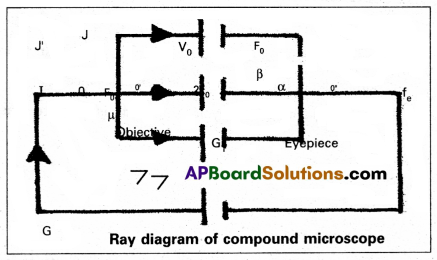
Working: The object OJ is placed outside the principal focus of the objective and the real image is formed on the other side of it. The image I1 G1 is real, inverted and magnified.
This image acts as the object for the eyepiece. The position of the eyepiece is so adjusted that the image due to the objective is between the optic centre and principal focus to form the final image at the near point. The final image IG is virtual, inverted and magnified.
Magnifying Power: It is defined as the ratio of the angle subtended by the final image at the eye when formed at near point to the angle subtended by the object at the eye when imagined to be at near point.
Imagining that the eye is at the optic centre, the angle subtended by the final image is α. When the object is imagined to be taken at near point it is represented by I J’ and OJ = I J’. The angle made by I J’ at the eye is β. Then by the definition of magnifying power.

Dividing and multiplying by I1 G1 on the right side, we get
m = (\(\frac{\mathrm{IG}}{\mathrm{I}_1 \mathrm{G}_1}\))(\(\frac{\mathrm{I}_1 \mathrm{G}_1}{\mathrm{OJ}}\)).
Magnifying power of the objective (m0) = I1G1 / OJ = Height of the image due to the objective. Height of its object.
Magnifying power of the eye piece (me) = IG/I1G1 = Height of the final image / Height of the object for the eyepiece.
m = m0 × me ………. (1)
To find m0 : In figure OJ O’ and I1G1O’ are similar triangles.
(\(\frac{\mathrm{I}_1 \mathrm{G}_1}{\mathrm{OJ}}\)) = \(\frac{\mathrm{O}^{\prime} \mathrm{I}_1}{\mathrm{O}^{\prime} \mathrm{O}}\)
Using sign convention, we find .that O’I1 = + v0 and O’O = -u where v0 is the image distance due to the objective and u is the object distance for the objective or the compound microscope. I1G1 is negative and OJ is positive.
∴ m0 \(\frac{\mathrm{v}_0}{\mathrm{u}}\) (∵ \(\frac{\mathrm{I}_1 \mathrm{G}_1}{\mathrm{OJ}}\) = m0)
To find me : The eyepiece behaves like a simple microscope. So the magnifying power of the eye piece.
∴ me = (1 + \(\frac{\mathrm{D}}{\mathrm{f}_{\mathrm{e}}}\))
Where fe is the focal length of the eyepiece.
Substituting m0 and me in equation (1),
m = + \(\frac{\mathrm{v}_0}{\mathrm{u}}\)(1 + \(\frac{\mathrm{D}}{\mathrm{f}_{\mathrm{e}}}\))
When the object is very close to the principal focus F0 of the objective, the image due to the objective becomes very close to the eyepiece.
u ≈ f0 and v0 ≈ L
Where L is the length of the microscope. Then
m ≈ –\(\frac{\mathrm{L}}{\mathrm{f}_0}\) (1 + \(\frac{\mathrm{D}}{\mathrm{f}_{\mathrm{e}}}\))
![]()
Question 20.
Obtain an expression for the torque on a current carrying loop placed in a uniform magnetic field. Describe the construction and working of a moving coil galvanometer.
Answer:
Torque acting on a coil carrying a current kept in a uniform magnetic field : Let a rectangular current loop ABCD of length l = AB = CD and width b = AD = BC carrying a current “i” be suspended in a magnetic field of flux density B.
The normal ON drawn to the plane of the coil makes an angle ‘0’ with the magnetic field B.
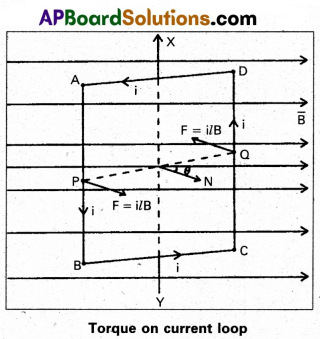
Force on arm AD = \(\mathrm{i} \overline{\mathrm{b}} \times \overline{\mathrm{B}}\) acting upwards along the axis of suspension
Force on arm BC = ib × B acting downwards along the axis of suspension
Hence these two forces cancel.
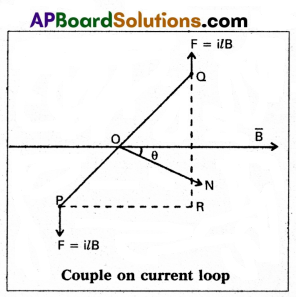
Force on arm AB = ilB acting perpendicular to the plane as shown.
Force on arm CD = ilB acting perpendicular to the plane as shown.
These two forces constitute a couple on the coil.
Moment of the couple = (Force) × (Perpendicular distance between the forces) = ilB (PQ sin θ)
Torque = ilB b sinθ
But l × b = Area of coil
∴ Torque = iAB sin θ
If the loop has ‘n’ turns the torque on the coil τ = ni AB sin θ If ‘Φ’ is the deflection of the coil, that is the angle between the plane of the coil and magnetic field B
τ = n i AB cos Φ
Moving coil galvanometer :
Principle : When a current carrying coil is placed in the uniform magnetic field, it experiences a torque.
Construction :
- It consists of a coil wound on a non metallic frame.
- A rectangular coil is suspended between two concave shaped magnetic poles with the help of phosphor Bronze wire.
- The lower portion of the coil is connected to a spring.
- A small plane mirror M is fixed to the phosphor Bronze wire to measure the deflection of the coil.
- A small soft iron cylinder is placed with in the coil without touching the coil. The soft iron cylinder increases the induction field strength.
- The concave shaped magnetic poles render, the field radial. So maximum torque acting on it.
- The whole of the apparatus is kept inside a brass case provided with a glass window.
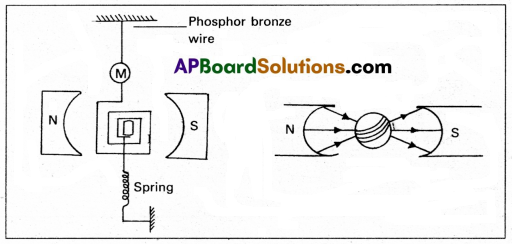
Theory :
Consider a rectangular coil of length l and breadth b and carrying current i suspended in the induction field strength B.
Deflecting torque (τ) = B i A N → (5)
where A = Area of the coil
N = Total number of turns.
The restoring torque developed in the suspension = C θ → (2)
Where C is the couple per unit twist and 0 is the deflection made by the coil. •
When the coil is in equilibrium position
Deflecting torque = Restoring torque
BiAN = Cθ
i = (\(\frac{\mathrm{C}}{\mathrm{BAN}}\))
Where K = \(\frac{\mathrm{C}}{\mathrm{BAN}}\) = Galvanometer constant.
i = K θ → (3)
i ∝ θ
Thus deflection of the coil is directly proportional to the current flowing through it.
The deflection in the coil is measured using lamp and scale arrangement.
![]()
Question 21.
Explain the principle and working of a nuclear reactor with the help of a labelled diagram.
Compare the radii of the nuclei of mass numbers 27 and 64.
Answer:
Principle : A nuclear reactor works on the principle of achieving controlled chain reaction in natural Uranium 238U enriched with 235U, consequently generating large amounts of heat.
A nuclear reactor consists of (1) Fuel (2) Moderator (3) Control rods (4) Radiation shielding (5) Coolant.
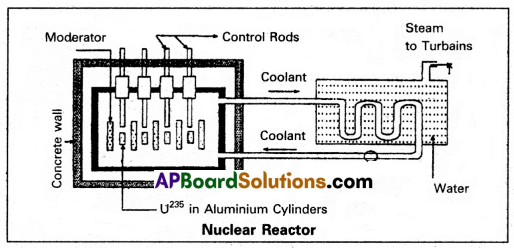
1. Fuel and clad : in reactor the nuclear fuel is fabricated in the form of thin and long cylindrical rods. These group of rods treated as a fuel assembly. These rods are surrounded by coolant, which is used to transfer of heat produced in them. A part of the nuclear reactor which use to store the nuclear fuel is called the core of the reactor. Natural uranium, enriched uranium, plutonium and uranium – 233 are used as nuclear fuels.
2. Moderator : The average energy of neutrons released in fission process is 2 MeV They are used to slow down the velocity of neutrons. Heavy water or graphite are used as moderating materials in reactor.
3. Control Rods: These are used to control the fission rate in reactor by absorbing the neutrons. Cadmium and boron are used as controlling the neutrons, in the form of rods.
4. Shielding : During fission reaction beta and gamma rays are emitted in addition to neutrons. Suitable shielding such as steel, lead, concrete etc are provided around the reactor to absorb and reduce the intensity of radiations to such low levels that do not harm the operating personnel.
5. Coolant : The heat generated in fuel elements is removed by using a suitable coolant to flow around them. The coolants used are water at high pressures, molten sodium etc.
Working: Uranium fuel rods are placed in the aluminium cylinders. The graphite moderator is placed in between the fuel cylinders. To control the number of neutrons, a number of control rods of cadmium or beryllium or boron are placed in the holes of graphite block. When a few 235U nuclei undergo fission fast neutrons are liberated. These neutrons pass through the surrounding graphite moderator and loose their energy to become thermal neutrons. These thermal neutrons are captured by 235U. The heat generated here is used for heating suitable coolants which in turn heat water and produce steam. This steam is made to rotate steam turbine and there by drive a generator of production for electric power.